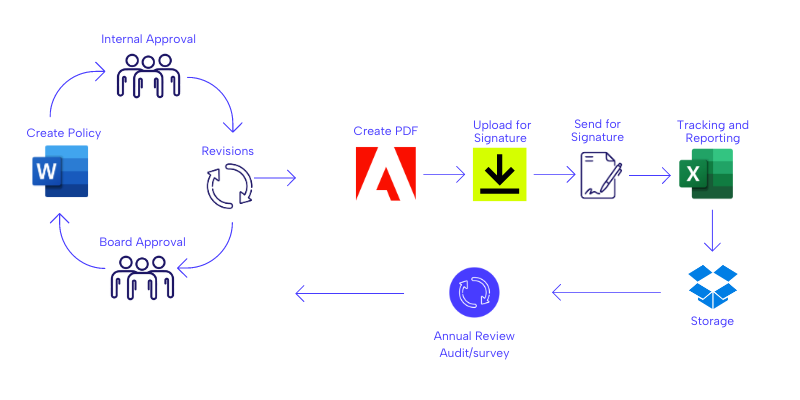Current healthcare trends are forcing change for organizations, including a hard look at healthcare policy management.
The continued high levels of staff turnover — 22.7% in 2023 — have dramatically turned up the volume on the number of new hires who need to review and acknowledge policies. These extra tasks are pushing already strained administrative staff to the breaking point. One HR manager recently told MedTrainer, “I can’t do this and everything else.”
Ensuring policies are up-to-date and followed is critically important for healthcare organizations, but the process shouldn’t take as much time as it does. While all types of healthcare organizations are feeling the pinch, it’s magnified for those with multiple locations and those working to maintain accreditation.
It’s time to find a better way.
WEBINAR: Take Control of Healthcare Document & Policy Management
Managing Policies in Healthcare
Let’s break it down with an example of how nearly every healthcare organization has handled policy management.
Start with a document creation tool, such as Microsoft Word, and a draft policy is emailed back and forth between team members, then to the governing board. Multiple people are simultaneously making edits in different ways, and it’s likely that some are missed in the final version.
The governing board needs to approve the final policy, which is either done in person at a board meeting or by using expensive electronic signature software. Once the governing board has signed off, then the policy needs to be distributed to all (or most) employees, acknowledged, and made easily accessible. Someone needs to track that all employees have received and acknowledged the policy since regulatory or accreditation surveyors will want to see the records.
Since the policies need to be reviewed every one to two years, this entire process repeats itself. For dozens of required policies.
Sound familiar? The practice above has been the standard for more or less the past 10 years at this point. So it’s understandable if your process falls into a similar pattern. But, it’s time to break the pattern.
According to the Journal of mHealth, navigating complicated compliance and regulatory requirements necessitates new technology solutions.
Benefits of Consolidating Your Healthcare Policy Management Process
Bringing every aspect of healthcare policy management into one digital platform eliminates wasted time, extra software, and outdated processes. Whether you’re moving away from a manual process or consolidating multiple digital technologies, there are many benefits to be gained.
Remove the Friction
Do you ever feel a bit like Wile E. Coyote chasing Roadrunner? Like you’re constantly chasing a signature or having to enter your password in a different system? A full-cycle healthcare policy management system will keep tabs on all revisions, approvals, and acknowledgements so you don’t have to. Everything is tracked in one platform without all the downloading, uploading, scanning, and moving from one software to the next. It’s ideal for organizations with multiple locations, where maintaining visibility and standardization is tough.
Save Money By Eliminating Software
Traditional electronic signing solutions are very expensive. Especially when additional software is required to manage other parts of the process. For example, many signing solutions don’t offer document creation or storage. With a full-cycle healthcare policy management solution, you may be able to eliminate as many as five other platforms. In addition to all the money you’ll save, you’re also juggling fewer contracts, logins, and support teams.
Onboard New Hires More Quickly
There are an average of 54 tasks to be completed for every new hire and combined with healthcare’s high turnover rate, this becomes a very tedious process. A full-cycle policy management solution makes it possible to automatically assign policy acknowledgement to new hires based on role, department, and location. This one-click solution sets new employees up for success while also freeing up time for administrators. See it in action.
Elements of a Full-Cycle Policy Management Solution
Policy Creation
Choose a policy management solution that offers the ability to both create and upload documents. You’ll probably also want the ability to offer fillable forms so that the HR team can get new hires to complete W2 and I9 forms online. Built-in collaboration tools also simplify the revision and approval process.
Policy Management & Reporting
Healthcare organizations need greater visibility into which employees have — and have not — reviewed and acknowledged policies. It’s why a policy management tool built for healthcare can be extremely helpful. Look for automated tracking and customizable reporting so you can set up reports that are ready for a regulatory or accreditation inspection.
Electronic Signatures
Incorporating electronic signing into the same place as document creation, management, and reporting is a game changer for healthcare organizations — especially those accredited by The Joint Commission. Be sure the solution you choose offers a mobile-friendly experience since many of your employees spend more time on their feet than behind a desk.
HRIS Integration
Choosing a policy management platform that integrates with your human resources information system (HRIS) further reduces the back-and-forth associated with healthcare’s high turnover rate. When new employees are added to the HRIS, they can be automatically assigned all required policies by role, department, or location. This is a huge time saver!
Why Trust MedTrainer for Healthcare Policy Management
MedTrainer is the only full-cycle healthcare policy management system built specifically for healthcare’s complex workflows. MedTrainer removes the burden of relying on multiple software and systems for policy management, offering a stress-free solution that simplifies everything in one place. Eliminate the back and forth with collaboration, version tracking, electronic signatures, storage, and reporting right within the MedTrainer platform. Automations such as reminders, tracking, and storage streamline the complex process.
MedTrainer Full-Cycle Policy Management
Combine MedTrainer Document & Policy Management with our robust learning management system to further simplify the compliance and new hire onboarding processes. There are nearly 1,000 trainings available in the course library, all designed specifically for healthcare organizations to meet regulatory and accreditation requirements. Plus, G2 reviewers consistently rate MedTrainer #1 in the Usability Index. It’s easy for admins to manage and it’s easy for healthcare staff to use.



